Venture with us into the thrilling world of the game as we explore various types of pickleball shots that ramp up the game to incredible heights.
Whether a seasoned player or a beginner, mastering these intricate techniques will undoubtedly sharpen your skills.
Understand the strategic elements behind dinks, volleys, serves, and more in this comprehensive guide.
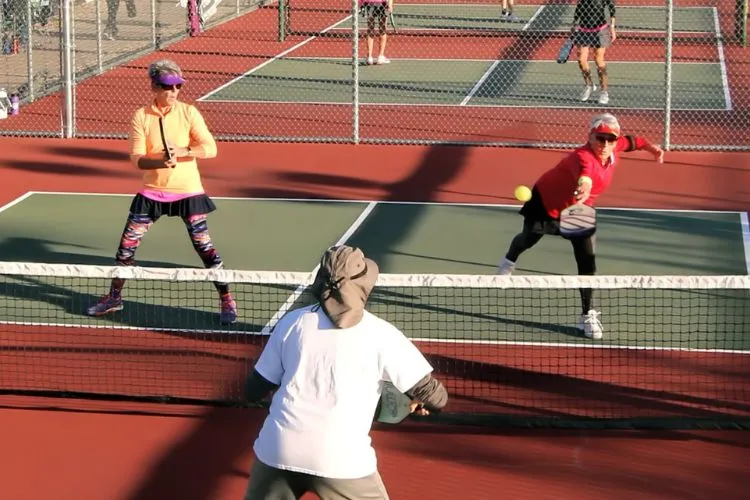
Let’s unlock the secrets to becoming a pickleball pro as we delve into different pickleball shots, each with its unique charm and effectiveness.
14 Types of pickleball shots
Pickleball, a riveting blend of tennis, ping-pong, and badminton, is a racquet sport that has gained immense popularity in recent years.
A vital aspect that separates the novices from the pros is the understanding and application of different types of shots.
Here, we dive deep into such shots, revealing how each elevates the game strategically and technically.
1. Serve
Every game of pickleball starts with a serve. It’s the only shot where you have complete control without opposition interference. The two types of serves you’ll use are the ‘Underhand Serve’ and ‘Lob Serve’.
The Underhand Serve uses a low-to-high motion keeping the paddle’s face below the wrist, ensuring the ball bounces once in the opponent’s service court.
The Lob Serve, on the other hand, can trick your opponent by sending the ball high and deep into the opponent’s court, causing them to backpedal and thus creating an open area for your next shot.
2. Return of Serve
Similar to the serve, a return is crucial in setting up the point. Generally, the best returns are low and deep, making it difficult for the serving team to attack.
The goal is to allow your team enough time to move forward to the net, establishing the line of scrimmage at the ‘No-Volley Zone’.
3. Dink Shot
A dink shot is a soft shot that is lightly hit over the net into the opponent’s non-volley zone (also known as the ‘Kitchen’).
This shot can be a great strategic move to force errors from your opponent, as the intention is to make your opponents hit upwards, leading to an easy volley opportunity for you.
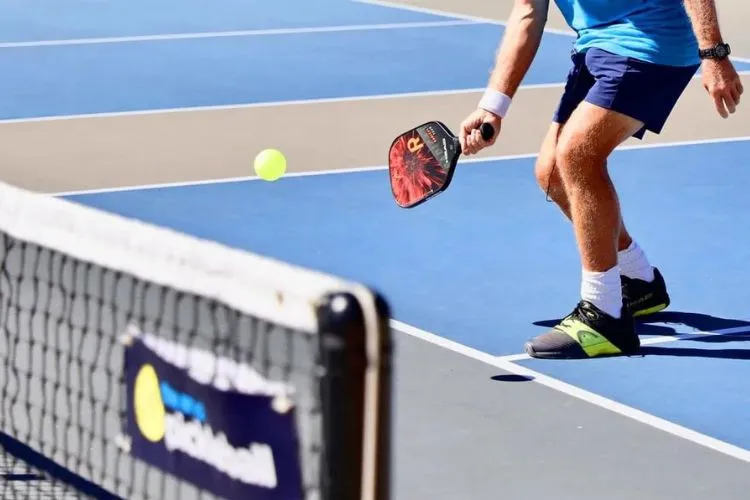
4. Lob Shot
A well-executed lob shot, usually an offensive strategy, can win crucial points. Being a high trajectory shot intended to pass over the head of an opponent, it can effectively move your opponents back off the net, opening up their court.
5. Volley
A volley in pickleball is a shot that is hit out of the air before the ball bounces. Excellent volley is all about quick reflexes and good hand-eye coordination. It’s a swift, offensive shot that prevents the possibility of the ball bouncing.
6. Smash
A shot indeed not for the faint-hearted, the smash is a powerful overhead shot used to finish a point decisively. It is similar to a tennis serve whacked from the baseline or a volley at the net, with the ball coming down steeply at high speed.
7. Drop Shot
A pickleball drop shot is a gentle stroke that falls just over the net into the opponent’s non-volley zone. It is a tricky shot, ideal for players at the baseline looking to approach the net by giving them enough time to advance yet keeping the returning ball low.
8. Third shot drop
The third shot drop is one of the most important shots to master in pickleball. It’s not about power but strategy, forcing opponents to hit an upward shot, granting you the chance to move closer to the net and gain advantage.
9. Drive
The drive is a shot hit at a relatively low arc, aiming to keep opponents on the defensive. As an offensive shot, the drive is typically fast-paced and direct, fired straight at your opponents before they have time to react.
10. Overhead Shot
The overhead shot in pickleball is an offensive maneuver, similar to the smash shot. This shot is usually the answer to a high-flying, poorly executed return from your opponent.
The goal is to use the height and angle of the incoming ball to generate power and direct it down into your opponent’s court, making it challenging for them to return. While accuracy is important, power also plays a crucial role in this shot.
11. Slice Shot
The slice shot adds a different dimension to your game. When executing a slice, the paddle strikes the ball with a high-to-low brushing motion, which imparts backspin on the ball.
The purpose of the slice shot is multi-fold: it can be used to change the pace of a rally, make the ball bounce low and tricky to return, or add variety to your shots to keep your opponents guessing.
12. Punch Volley
Punch volleys are an effective shot in pickleball, especially for quick, close-to-the-net exchanges.
In a punch volley, you respond to your opponent’s shot by “punching” the ball back using a forward thrusting action, keeping the paddle perpendicularly oriented to the ball’s trajectory.
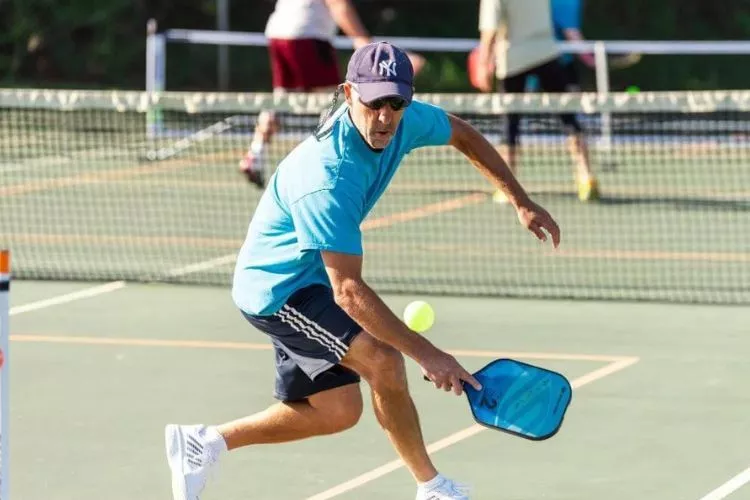
While the technique involves minimal backswing, it requires precise timing and firm wrist control. The objective is to catch your opponent off-guard with sudden, direct hits.
13. Around the Post (ATP) Shot
The ATP shot is a specialized shot in pickleball where the ball travels around the net post, instead of over the net, landing inside the opponent’s court.
To execute an ATP, you need to identify when the ball is traveling wide enough for you to hit the ball around the net post. The ball should have a lateral spin to curve it back into the court. Mastering this shot can bewilder your opponent and win you points right away.
14. Erne Shot
Named after Erne Perry, a pioneer in executing this shot, the Erne shot is an aggressive volley shot, where you essentially catch the ball in the air while standing outside the court, right next to the net.
The player sneaks from the sideline towards the net post, catches the opponent’s shot in the air, and volleys the ball into the opponent’s court. Being an advanced-level shot, the Erne shot leaves your opponent’s court wide open, earning you a point.
Each of these shots adds a different dimension to your game-playing strategy, exploiting your opponent’s weaknesses and keeping them on their toes.
By mastering these shots, you will be equipped to handle a variety of game scenarios and improve your overall performance. Practice is the key to executing these shots flawlessly within a match.
6 Types of Beginner pickleball shots
Here are some types of pickleball shots that are essential for beginners to learn as they start their journey in this sport:
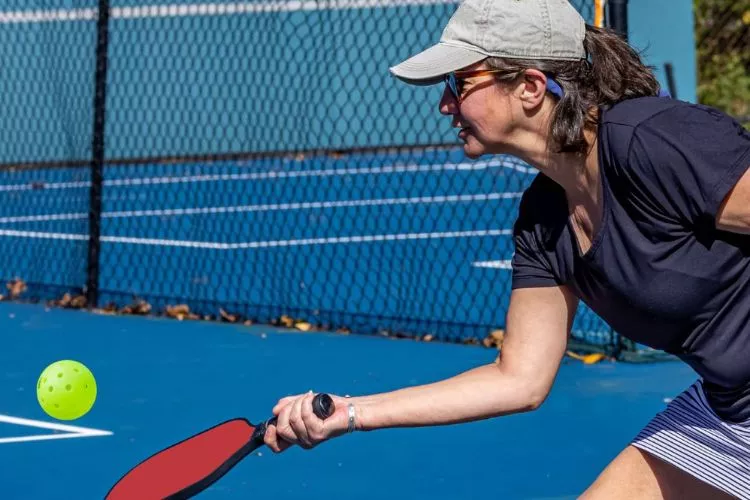
- Serve: An underhand serve is used to initiate the game. This shot requires you to hit the ball with a low-to-high motion, ensuring it bounces once in the opponent’s service court.
- Return of Serve: This shot is your response to the serve, and it helps set up the point. Try to execute the return of serve by hitting the ball low and deep into your opponent’s court.
- Dink Shot: As a beginner, you should learn this soft shot that is lightly hit over the net into the opponent’s non-volley zone (or the ‘Kitchen’). It’s a strategic shot meant to force errors from your opponent.
- Volley: This pickleball shot is hit out of the air before the ball bounces. It’s crucial to develop quick reflexes and strong hand-eye coordination while growing your skills.
- Groundstroke: Any shot made after the ball has bounced once is called a groundstroke. Most of the shots you’ll make in pickleball, like dinks, will be groundstrokes.
- Lob Shot: A lob is a high trajectory shot intended to pass over the head of an opponent. Learning to execute the lob shot disrupts your opponent’s positioning and helps you gain the advantage in a rally.
It’s important to start with these basic shots as a beginner in pickleball. As you develop your proficiency, you can gradually add more advanced shots to your arsenal.
Remember that practice is the key to mastering these shots and becoming a better pickleball player.
Pickleball advanced shots
Certainly! Here’s a set of advanced pickleball shots every advanced player should consider mastering:
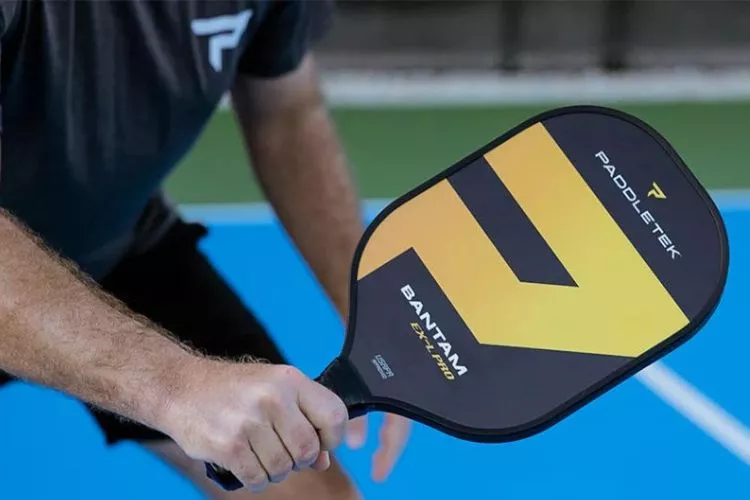
- Third-Shot Drop: This is one of the most critical shots to master in pickleball. It’s a strategic, soft shot aimed at landing in the opponent’s non-volley or kitchen zone. When properly executed, this shot allows you to move up to the net and set up for a winning volley.
- Reset Shot: The reset shot is a strategic gameplay shot that allows you and your partner time to get into a better position, especially when being attacked by the opponents. It’s a soft, low-paced shot, usually directed at the opponent’s feet.
- Erne Shot: Named after the player who first mastered it, Erne Perry, the Erne shot is an aggressive, preemptive shot that involves stepping outside and around the kitchen to hit a volley into the opponent’s court.
- Drive Shot: The drive shot is a powerful, low-lying shot aiming to apply pressure on the opponent. It’s typically hit with a flat paddle face and intended to reduce the opponent’s reaction time.
- Topspin and Slice Drop Shot: Advanced players often add both topspin and backspin to their drop shots to make it more challenging for their opponents. A topspin drop shot dips faster over the net, meaning it can hit from a higher point and still land in the kitchen. In contrast, a slice or backspin drop shot adds an underspin to the ball, causing the ball to stay low and bounce unpredictably after landing.
- Around The Post (ATP) Shot: In this challenging shot, the player hits the ball around the net post instead of over the net, making it land within the opponent’s court. This shot is usually employed when the ball’s flight path is wide enough to go around the post.
By mastering these advanced shots, a player can elevate their playing level and get an edge over their opponents in matches.
Conclusion:
Mastering various pickleball shots, from basic to advanced, is crucial to becoming a versatile and successful player.
By understanding each shot’s purpose and technique, players can develop a strong foundation, enabling them to advance skillfully while adapting to diverse game scenarios.
As you progress in the sport, challenge yourself to learn and perfect different shot types to keep your opponents guessing and continuously improve your performance.
Always remember—practice and perseverance are the keys to conquering the pickleball court.

Pickleball’s more than a game to me—it’s a passion. I write, sharing its highs and lows, the thrills and the lessons. Some tales might draw you to the court, while others give a hint of the game’s magic. So, curious about my journey? Ready to dive deep into the world of pickleball with me? Let’s go.
